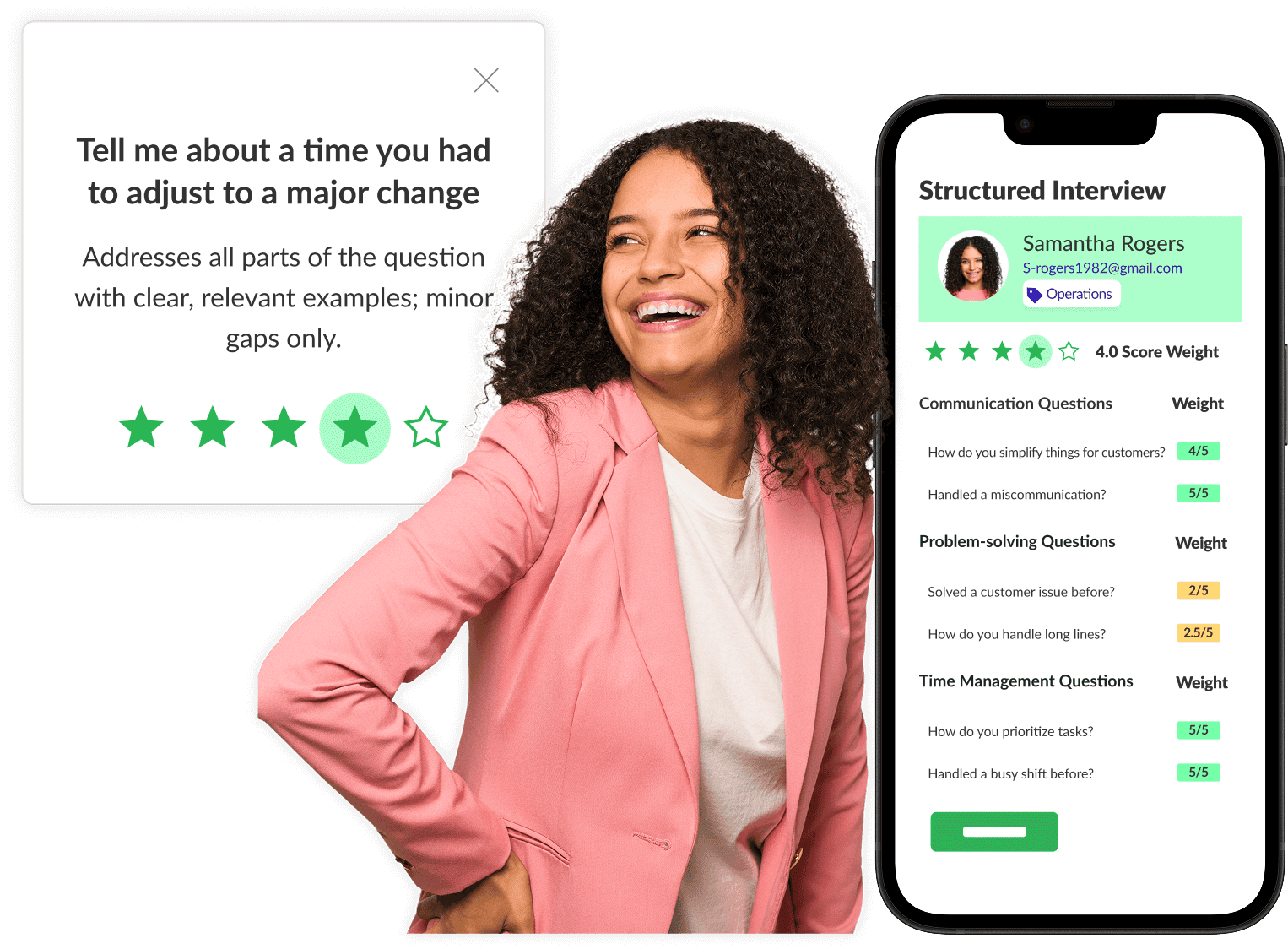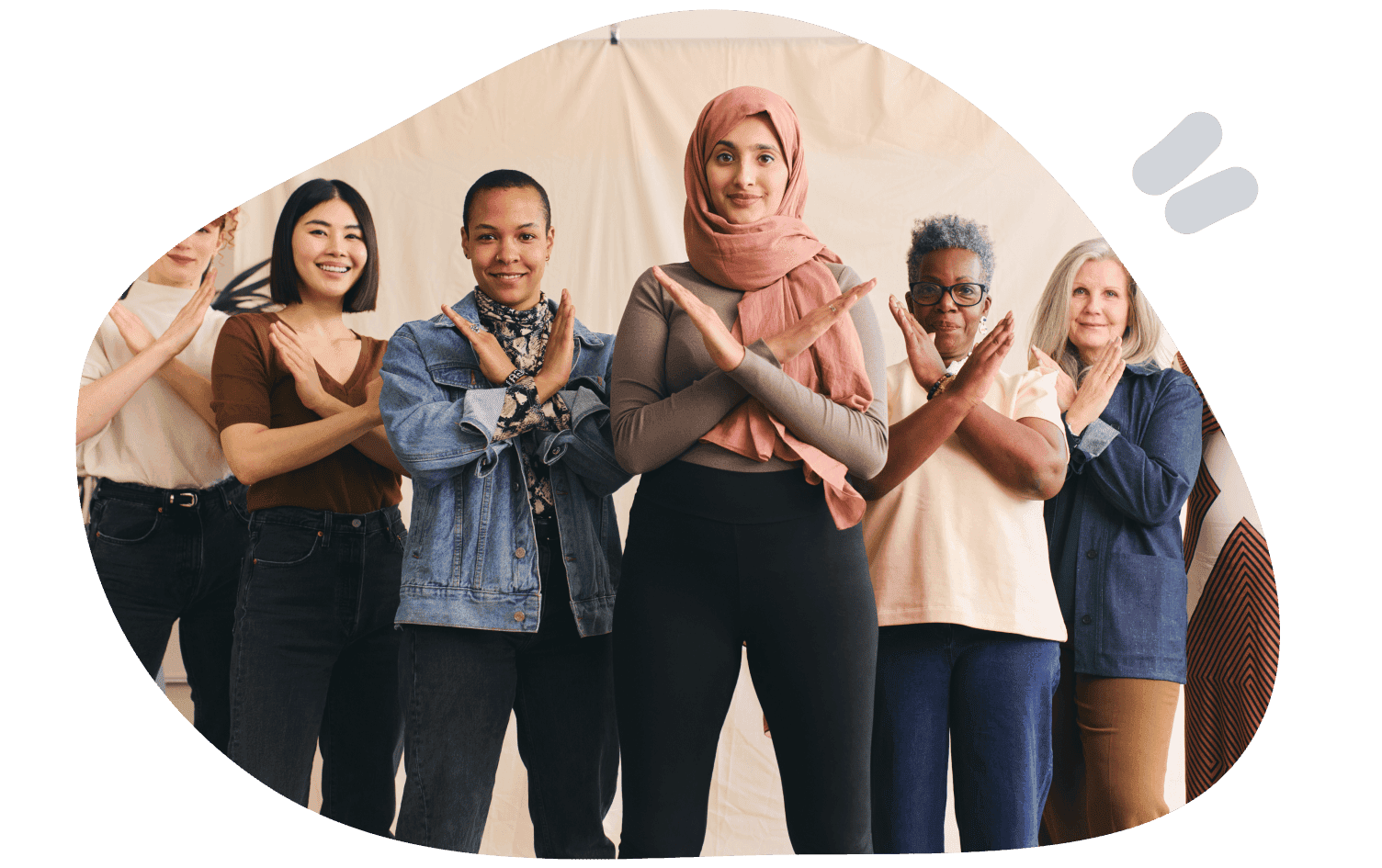Why Structured Interviewing Reduces Bias
Written by
VidCruiter Editorial TeamReviewed by
VidCruiter Editorial TeamLast Modified
Nov 5, 2025
TL;DR: How to Reduce Hiring Bias
- Leverage structured interviews so each candidate receives the same questions in the same order.
- Define the key competencies and skill sets for the position to use as the basis for structured interview questions.
- Train interviewers on the best practices of conducting a structured interview, including how to score responses based on answers given.
- Continue to refine your structured interview process over time by measuring the effectiveness of the hire and if the role’s proficiencies evolve.
- Choose technology that streamlines structured interviewing and provides a fair and equitable experience for each candidate.
How effective is your interviewing plan? Is it consistent across candidates? Does it have a formal plan with strategies that address bias? Bias is everywhere, and most of the time, we’re not even aware of it. However, if you want to reduce bias, structured interviews have proven to be an excellent approach.
As companies strive to create bias-free hiring practices, it’s critical for stakeholders responsible for recruitment to consider how effective their current interview procedures are in limiting bias. While it may be impossible to eliminate it completely, with the right approach, your organization can make improvements. Learn all there is to know in this structured interview guide, and what technology tools are available to help you.

What Is a Structured Interview?
A structured interview sounds very much like what it is — an interview with structure. A standard structured interview definition is a conversation between a hiring manager and a candidate that involves a defined set of questions.
Because there is standardization in the questions, it creates a consistent, systematic process for interviewing and evaluating applicants. It also supports fair hiring practices.
An interviewer asks the same questions in the same order. In addition to the actual interview, there are other aspects of this process. These include a job analysis of the abilities, qualifications, and attributes most valuable to that position. This is often the foundation of building the questions.
The second piece of the structured interview process is scoring the responses. An interview scorecard can be essential in reducing bias in assessments, so that you’re focusing on the knowledge, skills, and position fit versus any other factors.
The Value of Structured Interviewing
The value of structured interviewing makes sense fiscally as well. Bad hires create turnover, which costs companies, on average, $17,000. Businesses don’t want to waste time and resources on someone who isn’t going to work out long-term.
Structured interviews deliver better results. Academic research suggests that adding structure to the interview process can enhance the reliability and predictive validity of evaluations.
If your company wants to be forward-thinking about removing bias from interviews, you’ll need to understand how it happens.
How Bias Appears in Interviews
Bias almost always emerges in conversations with others. Much of the time, you may be completely unaware of it. It’s human nature to gravitate toward those with similar perspectives and backgrounds. It’s comfortable.
When you interview someone who seems more different than alike, bias can creep in and be subconscious. Why does this happen? There’s a phenomenon called confirmation bias. It means that people tend to seek out something that “confirms” one’s beliefs or values.
During an interview, confirmation bias may immediately arise in someone’s perception of another. How this manifests is that the interviewer begins to look for information that supports their first impression of the applicant’s skills. The impression may be an unfair assessment based on physical looks, the university they attended, or previous employers.
Those are actually not very relevant to whether that person is a good fit for the position. They can cloud judgment. Candidates who would have been great employees could be dismissed, and bad candidates could be hired.
Is Bias Always Unconscious?
Bias may not always be unconscious. It can be more obvious if the interviewer has personal feelings toward a group that is unlike them. It could be something like wondering if an older applicant can “keep up” with a young team. Another example is a judgment against someone who is a working parent.
When bias becomes judgment, it can lead to bad hiring decisions. To mitigate this, structured interviewing offers a path, and there are specially designed technology tools that allow you to do this at scale.

Why Structured Interviews Reduce Bias
Harvard Business Review points to structured interviews as a key way to neutralize bias. In the article, they discuss their own frameworks for reducing unconscious bias by “focusing on the factors that have a direct impact on performance.”
In addition to standardizing questions, Harvard Business School also recommends work sample tests. Candidates are provided with the same problem to solve, allowing for an objective review of their skills.
Another interesting note about this interview strategy is that it can improve the candidate experience. That’s something that many companies struggle with, and it can actually keep them from landing the best applicants.
Informing potential hires that you’re using a structured framework for the interview and its benefits could put them at ease. It gives them an idea of what to expect, whereas unstructured interviewing may make them more anxious.
Let’s review key ways of how to reduce hiring bias through structured interviewing.
They Are Built on Fairness and Objectivity
Every person gets the opportunity to answer the same questions. It may seem simple, but consider all the different biases that could occur if each candidate had a completely unique set of questions.
You can eliminate much personal bias with this option. Overall, this fosters a hiring culture of transparency and equity.
How do you ensure fairness and objectivity? By empowering your team with easy-to-use tools to conduct a compliant interview. Our solutions include:
- The ability to upload pre-existing and vetted questions to our platform for hiring managers to use in assembling their questionnaire
- Keeping interviewers accountable with completion tracking and automated reminders in our applicant tracking system (ATS)
- Auditing hiring managers’ ratings from recorded interviews to ensure they are following standards and upholding criteria

Predefined Scoring Drives Decisions Based on Skill
Interview scorecards enable hiring managers to be objective in grading applicant answers. You’ll see more objective feedback versus unstructured interviewing. You can start with templates like those available on our platform. It saves time, especially if it’s a role you hire for frequently.
Streamlining Interviewing Supports Reducing Bias, Too
Adopting structured interviewing also makes the entire hiring cycle more efficient. Why does efficiency matter? Delays in setting up interviews because people aren’t prepared should no longer occur. It also decreases confusion for those interviewing and hiring about what the process is.
There’s also less small talk or irrelevant conversation, giving time back to your staff and applicants. It becomes a very controlled interaction, which can deter bias. A streamlined workflow becomes the standard when you use our ATS, video interview platform, and interview compliance features.
Best Practices for Bias-Free Interviews
The structured interview process has many interpretations. It’s not necessarily one-size-fits-all, as each industry and company is unique. However, there are many best practices you can adopt to ensure stronger bias-free hiring.
Create Uniform Questions
The first step in how to reduce bias in hiring processes is developing the questions. So, how do you start this? Follow these tips:
- Define the competencies that are essential to the role: You can begin this exercise by documenting hard and soft skills that someone needs to be successful in the job. Make this list detailed with qualities the ideal candidate should possess.
- Craft job-specific questions: What you ask should be relevant to the position and its requirements.
- Consider how questions can lead to an interviewee expounding on their experiences as related to the job. They should be specific, not general traits, as that can cause bias to appear.
- Document your rating system: You should create a standardized way to score the responses of candidates. Much of the time, companies use a five-point scale to assess.
- Ensure interviewers are proficient at structured interviews: All your hiring managers will need training on the concept. Make this part of your regular training curriculum.
Curating all these questions in a centralized spot is possible with our Interview Management System (IMS). The solution also includes built-in interview guides to keep the conversation on track.
Design Interview Scorecards/Rating Systems
Interview scorecards are a critical part of addressing bias. It builds on your commitment to fair and equal evaluations. When conceiving the rating system, consider these things:
- Begin with clear parameters based on the position’s requirements by choosing five to 10 key attributes. They should include hard and soft skills.
- Make sure evaluation criteria always link to the job’s requirements.
- Use standard rating scales.
- Include room for explanation of scoring and comments.
- Add core attributes that create a complete picture of the person.
- Instruct interviewers to rate as they go, which can reduce recency bias (putting too much emphasis on what people say at the end).
Build a Diverse Interview Panel
Not every role may need multiple interviewers, but it’s still a good hiring practice. When evaluators come from different backgrounds and have unique perspectives, it’s proven to be good for hiring fit. The reason is that a panel can neutralize individual biases.
These interviewers will bring their own perspectives and often identify an array of strengths and weaknesses. Some pointers on putting together an interview team:
- Involve people from different departments who work in shared roles.
- Ensure team member representation includes those with varying backgrounds, genders, ethnicities, and experience.
- Add subject matter experts with deep knowledge of the role.
- Include someone who has completed bias identification training.
Review Interview Results with an Objective Eye
After the interview and the grading, it’s time for the final appraisal of a candidate’s fit for the role. The first thing is to make sure interviewers take notes during the conversation. If they depend only on their memory, they are apt to forget things. Memory bias can have a considerable impact on hiring decisions.
Without notes, people will fall into patterns of bias rather than what the candidate actually said. One way to do this without the interviewer shifting attention is with our AI interview notes tool. Additionally, our platform lets you generate a transcript of the candidate’s answers from recorded interviews.
How Software Supports Bias Reduction
Now that you’ve learned all about bias and structured interviews, you may have concerns about how this would work practically and at scale. As with any process in your company, software has an answer.
Here are our tools that support structured interviews and reducing bias.

Interview Management System (IMS)
Our IMS takes interviewing to the next level of effectiveness, efficiency, and fairness. It enables structured interviewing and automation while using ethical AI. Use it to create ideal interview workflows, build an evaluation process, identify insights, and use data collected to improve processes.
Video Interviewing Platform: Pre-Recorded and Live
Having a dedicated application for interviewing can be crucial in objective hiring. These solutions aren’t just another Zoom. There are two options: pre-recorded and live.
Pre-recorded interviews allow candidates to answer the questions at their convenience. They receive the questions and have a predetermined timeframe to respond. This can be especially helpful if you are trying to decrease time-to-hire. It also eliminates scheduling conflicts that slow down the process. Our solution includes a built-in structured rating as well.
Live video interviews take place just like any meeting on a virtual platform, except these have special features for hiring. One great capability is the ability to rate candidates in real time. Multiple interviewers can also collaborate and share feedback.
These systems may also have interview scheduling software to make getting it on the calendar more efficient. There are also configurations for group and panel interviews.
Applicant Tracking Systems (ATS)
Does your ATS have features for structured interviewing and bias reduction? The VidCruiter ATS does!
Our system allows for internal policy controls, can leverage analytics, and automates workflows. All these features address hiring bias. It may also identify barriers in the application process that limit accessibility.
AI Interview Tools
With AI interview notes, you can:
- Access accurate live interview notes.
- Accelerate the hiring pipeline with faster candidate evaluation.
- Reduce bias and ensure compliance with interview records.
Final Thoughts on Structured Interviews and Bias
Can you eliminate bias in every candidate interview? It all comes down to human nature, which is hard to control. What you can do is create a process that aims to neutralize it so it doesn’t play such a significant role in hiring decisions.
Structured interviews provide a path to consistency across conversations. It’s one of the best ways to ensure people get the same opportunity. The more you can decrease bias, the more likely you are to hire smarter, which is good for companies and applicants. It’s a win-win when an experienced and well-qualified hire joins the team.
Learn more about structured interviewing and candidate assessments.
Frequently Asked Questions
What Is hiring bias?
Hiring bias is an umbrella term that can include lots of subcategories. In short, it refers to candidates not being treated equitably during the recruitment process. Sometimes it’s conscious; other times it’s unconscious. It can derail diversity goals and lead to bad hiring decisions.
What’s the difference between structured, unstructured, and semi-structured interviews?
Structured interviews ask the same questions to all candidates. Unstructured interviews do not follow this pattern. Each applicant could have a different experience because questions aren’t standardized. Semi-structured interviews combine both. Some parts of the discussion may include prepared questions asked to every candidate and could end with a mix of questions. The interviewer may just react on the spot based on the answers provided.
What types of bias impact hiring?
There are many types of bias. Those that are most associated with hiring include confirmation, memory, and personal bias. There’s also the halo effect, which occurs when one positive quality causes someone to assume someone has many more.
What should businesses look for in terms of technology to help reduce bias?
Companies can invest in interviewing solutions that support structured interviews. The most important thing is a video interview platform that has features that support this framework, including the ability to rate people in real time. AI notetaking tools are useful, too, as they provide an exact transcript. Finally, your ATS should have capabilities that allow you to treat every applicant fairly during the process.